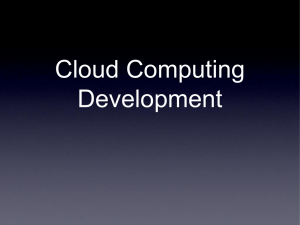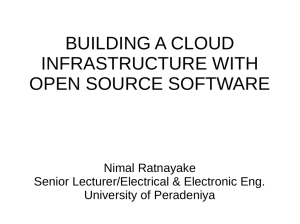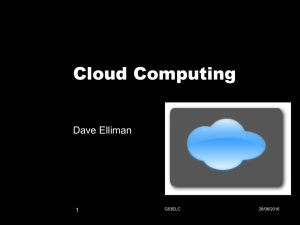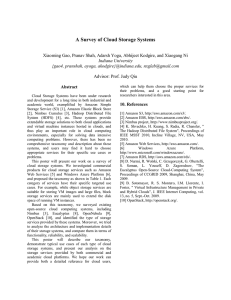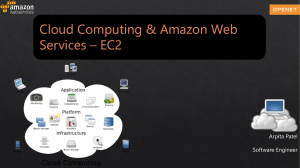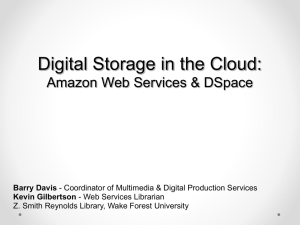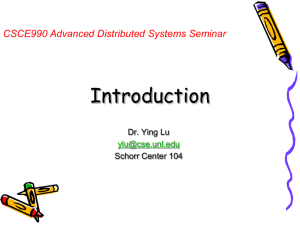OpenStack Storage
advertisement
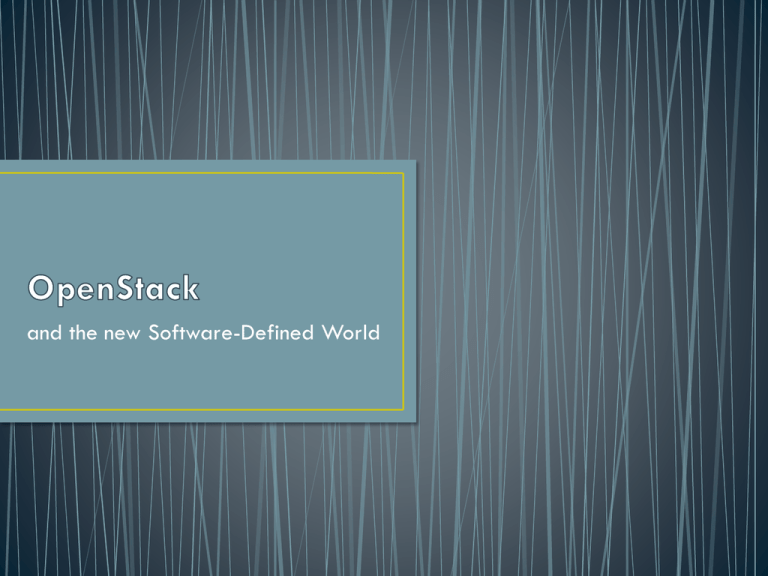
and the new Software-Defined World • • • • IT consultants to the Intelligence Agencies Primarily NSA IT architectures and infrastructures Virtualization Deconstructing the Cloud – Answers to burning questions like: • • • • • What is virtualization? History of Virtualization State of the art What’s in a cloud? Directions • • • • Layer of abstraction Multiplexing Mainframes Why aren’t we all on terminals? • Compute as a Utility described in the 1950s • • • • The Pizzabox 1 OS 1 App X86 underutilization Power space and cooling • • • • • • Big server farm Excess capacity Proposal for an external service in 2004 Opened for business in 2006 Exceeds $1 billion in revenue 2011 Crashes on Christmas 2012 (Netflix) • • • • Elastic Block store – cloud storage Amazon Cloud Watch – health and status Auto scaling – spawn instances on demand Elastic Load Balancing – distribute network load evenly among instances • High performance computing - clusters • VM import/export – build it at home, move it to the cloud • Free Tier* • As part of AWS’s Free Usage Tier, new AWS customers can get started with Amazon EC2 for free. Upon sign-up, new AWS customers receive the following EC2 services each month for one year: • 750 hours of EC2 running Linux/Unix Micro instance usage • 750 hours of EC2 running Microsoft Windows Server Micro instance usage • 750 hours of Elastic Load Balancing plus 15 GB data processing • 30 GB of Amazon EBS Standard volume storage plus 2 million IOs and 1 GB snapshot storage • 15 GB of bandwidth out aggregated across all AWS services • 1 GB of Regional Data Transfer • Open source version of EC2 • Now partnered with Amazon • Allows public private transitions – hybrid clouds • July 2010 – NASA and Rackspace announce OpenStack release Austin • The back story • Early summer 2010 “Apache-Licensed Cloud Computing, in Python. It’s live, it’s buggy, it’s beta. Check it out.” • Rackspace begins parallel development • NASA and Rackspace meet for Thai food • Working at the Rainbow Mansion • 5 weeks later . . . NASA administrators agree to release everything under the Apache license • June 2012, NASA moves its compute architecture to Amazon • Nova - Openstack defines as compute, but is really a manager of compute assets • nova-api - interprets commands • nova-schedular- determines where to run VM • nova-compute - start VM • nova-network - assign address • Not a hypervisor – sits on top • • • • • Quantum (Fulsom release) Virtual Distributed switch/Nexus 1000v Essex release - simple flat, DHCP, VLAN, Floating IPs (NAT) Network proxy node Bridging • • • • • • • Glance – image repository (MySQL database) Data equivalent to part of VMDK Swift – object store Data disks, ISOs, the junk drawer Volumes – elastic storage (iSCSI) SAN/NSA attached disks Flavors - define amount of memory, CPU, disk size “Amazon [is] at war with every IT vendor out there,” says Sebastian Stadil, the CEO of an open source cloud management outfit Scalr, the founder of the Silicon Valley Cloud Computing group, and a former resident of the Rainbow Mansion. “I think one of the reasons OpenStack is getting so much traction — despite, to be frank, iffy stability — is that it represents the industry’s only hope to survive.” Wired April 2, 2012 • • • • • • Encapsulation True virtualization vMotion Snapshots Storage vMotion Fault Tolerance • • • • • DRS Power management Storage DRS Hot Add CPU and Memory Para-virtualization and Pass-through • • • • Compute Storage Network How is this different than what we have now? • Compute • VCPUs • One to one mapping • Over-subscription • Network • Virtual Switch • Virtual Distributed Switch • Storage • VMDK • RDM • ISCSI • Proprietary • Cisco • Brocade • Juniper • ASIC • Merchant Silicon • Commodity • • • • • Direct Attached RAID SAN NAS Clustered NAS • • • • Object based storage Google File system Hadoop Swift • • • • • Virtualization Commoditization Software defined networks Software defined storage Software defined data centers • Time sharing / multiplexing • Hyperthreading- For each processor core that is physically present, the operating system addresses two virtual or logical cores, and shares the workload between them when possible. They appear to the OS as two processors, thus the OS can schedule two processes at once. In addition two or more processes can use the same resources. If one process fails then the resources can be readily re-allocated. • Multi-core - a single computing component with two or more independent actual central processing units (called "cores"), which are the units that read and execute program instructions. • Where does it end? Intel has already released 48 core experiemental processors • • • • Software Defined Networks OpenFlow Nicira Big Switch • Commodity storage • Lefthand Storage • ISCSI • Isilon • Software Defined Storage • Nexenta • ScaleIO Pat Holben Zot Inc.
